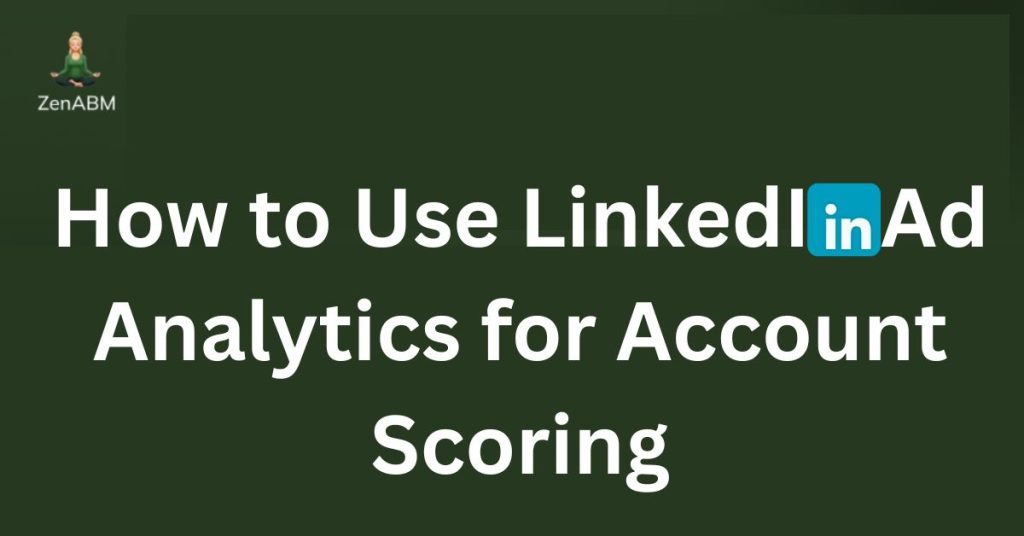Having mountains of LinkedIn ad data but struggling to make sense of it?
In this article, I have laid out all that you need to use LinkedIn ad analytics for account scoring for your ABM campaigns. Experts on social media and Google had a lot to say about this. So I have compiled the most consistent and actionable tips I found during my research.
And yes, ZenABM can help with LinkedIn ad data-led account scoring, and I have discussed that here.
Read on!
How to use LinkedIn ad analytics for account scoring: quick summary
- Account Scoring = ABM Superpower: In ABM, account scoring helps you laser-focus on high-potential companies and align marketing and sales on which accounts are most likely to convert instead of chasing every lead. With only ~5% of your market actively in-market at any time, a good scoring model ensures you catch that 5% when it counts.
- Clicks Don’t Tell the Full Story: Traditional ad metrics like CTR fall flat for ABM. LinkedIn CTRs hover around 0.4–0.5%, which means most interested buyers never click. If you only score accounts that click, you miss those who saw your ads and converted later via another channel. Cookie-based tracking and IP lookup tools will not save you either. One real-world test identified only 1 out of 300 ad viewers. Old-school metrics leave big blind spots.
- LinkedIn Engagement = Intent Signals: LinkedIn’s ad analytics, especially the Companies report, show which companies engage with your ads. If Acme Corp keeps viewing and interacting with Product A ads, that is a strong buying signal. Native tools aggregate at the account level, not by individual campaign, so you cannot tell which message resonated. Go deeper for true intent.
- Key Data Points for Scoring: Go beyond clicks. Track impressions, engagements (likes, comments, shares), and clicks. Add recency and frequency. Effective models weight recent activity more and assign higher points to deeper interactions, for example, a click is worth more than an impression. The goal is to quantify how actively each account shows interest.
- Designing a Scoring Model: Start simple. Example: 1 point per impression, 5 per click, 10 per LinkedIn form fill. Add decay after X weeks with no activity. Adjust weights to fit your funnel; for example, comments can carry extra weight. Bubble up the hottest accounts from cumulative engagement. Reset or reduce scores over time so silent accounts do not stay hot. A blended model that weights recency, frequency, and interaction type works well. When the score spikes, it signals buying interest.
- Automate Score Updates in Your CRM or MAP: Manual scoring will not scale. Sync LinkedIn company engagement to your CRM as company-level fields such as “LI Impressions Last 7 Days” and “LI Clicks Last 7 Days.” Recalculate a score and trigger alerts when thresholds are crossed. Native integrations are limited, so consider a specialized tool. At ZenABM, these metrics flow into the CRM and update the “LinkedIn Ad Engagement Score” continuously.
- ZenABM Makes It Easy: ZenABM captures company-level LinkedIn engagement via the LinkedIn API and maps it to target accounts. It calculates a real-time engagement score for each account, counts view-through, and can auto-assign hot accounts to sales when the score spikes. It also tags engagement by campaign and intent, so reps know what the account cares about. All of this syncs to your CRM as company properties for real-time scoring and alerts without spreadsheets.
Why Account Scoring Matters in ABM
Account scoring is the backbone of a successful ABM strategy.
Why?
Because ABM isn’t about volume; it’s about precision. You have a finite list of target accounts that could be high-value customers – your job is to figure out which of those companies are warming up to your outreach, and which ones aren’t worth your focus right now. Traditional lead scoring (scoring individual people) doesn’t cut it for ABM, where you’re selling to a buying committee. You need to look at the account as a whole.
In other words, it keeps everyone focused on the right companies, not just the right leads. Another reason account scoring is crucial: timing. Industry data indicate that only about 5% of your target market is actively searching for a solution like yours at any given time. If you can identify the 5% (in-market accounts) and alert your sales team, you gain a huge advantage. Scoring models help surface those telltale signals (web visits, ad engagement, content downloads, etc.) that indicate an account is in a buying cycle.
It’s the difference between your sales team calling a company that has no idea who you are, versus calling after that company spent the last week bingeing your LinkedIn content and visiting your pricing page.
Why Traditional Ad Engagement Metrics Fall Short for Account Scoring
LinkedIn Ads are a fantastic ABM channel because they let you get in front of the right people, but those people rarely click on the ads. The average LinkedIn ad CTR is around 0.4 to 0.5%.
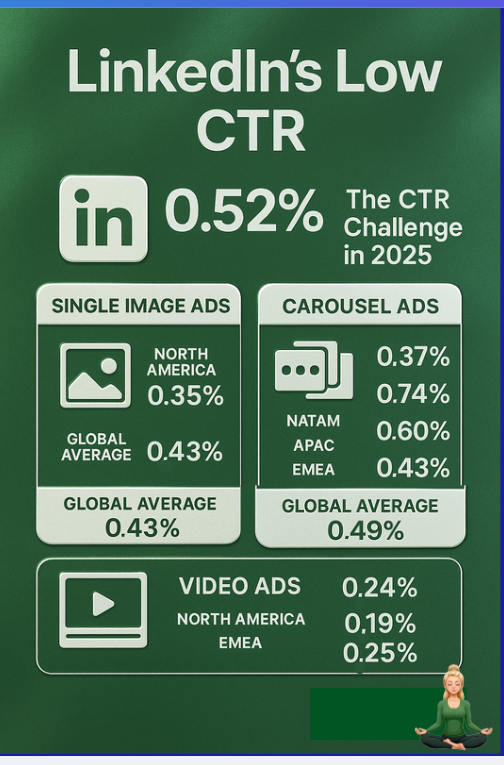
That means 199 out of 200 people who saw your ad didn’t click it.
Does that mean they felt no impact?
Of course not.
Many may visit your website later, Google your brand, or read an email from you after seeing your LinkedIn ad. But if you’re only tracking clicks, all those accounts look “inactive” and your reports undervalue LinkedIn’s influence as a result.
Say Acme Corp is on your target list. Five people see your LinkedIn ads in a month but don’t click. A week later, one Googles your product and visits your site; another fills out a demo form. Traditional analytics credit Google or your site, missing LinkedIn’s “assist.” Scoring only on clicks would give Acme zero, ignoring their warming interest. That’s why view-through engagement matters in ABM and why LinkedIn’s native reports miss it when different people from the same company take action.
Traditional metrics focus on individual leads/MQLs. But in ABM, you care if anyone from Acme engaged. Maybe the CTO ignored your ad, but a director clicked – that’s still buying committee engagement. Conventional tracking might miss it if the CTO later becomes the opportunity. Account scoring solves this by aggregating activity at the company level.
Marketers have attempted patchwork solutions to fill these gaps, like:
- Using IP de-anonymization tools to identify which companies visit your site from an ad. The problem is, these tools are often inaccurate in B2B scenarios. VPNs, shared office networks, and mobile devices throw them off. A LinkedIn ABM campaign case study by Userpilot showed that an IP matching tool recognized only one company out of 300 ad visitors (and that one was the marketer’s own company!). That’s <1% accuracy, essentially useless. Even the better-case studies report ~40% accuracy on matching clicks to accounts.
 So, chasing anonymous web traffic isn’t a reliable way to measure your LinkedIn campaign impact.
So, chasing anonymous web traffic isn’t a reliable way to measure your LinkedIn campaign impact.
The takeaway: ABM needs a different lens. We can’t judge an account’s interest solely by direct clicks or last-touch attribution. Instead, we need to capture all the meaningful interactions an account has with our ads and content, including passive engagements like viewing an ad and measure those cumulatively. That’s the only way to fairly score an account’s true engagement level. It’s a shift from a lead-centric, click-centric mindset to an account-centric, engagement-centric one.
How LinkedIn Ad Analytics Can Signal Account Intent
Let’s focus specifically on LinkedIn ad analytics now.
- LinkedIn has introduced some features in the last couple of years that are incredibly useful for ABM, particularly the Company Engagement Report (now surfaced as the “Companies” tab in Campaign Manager).
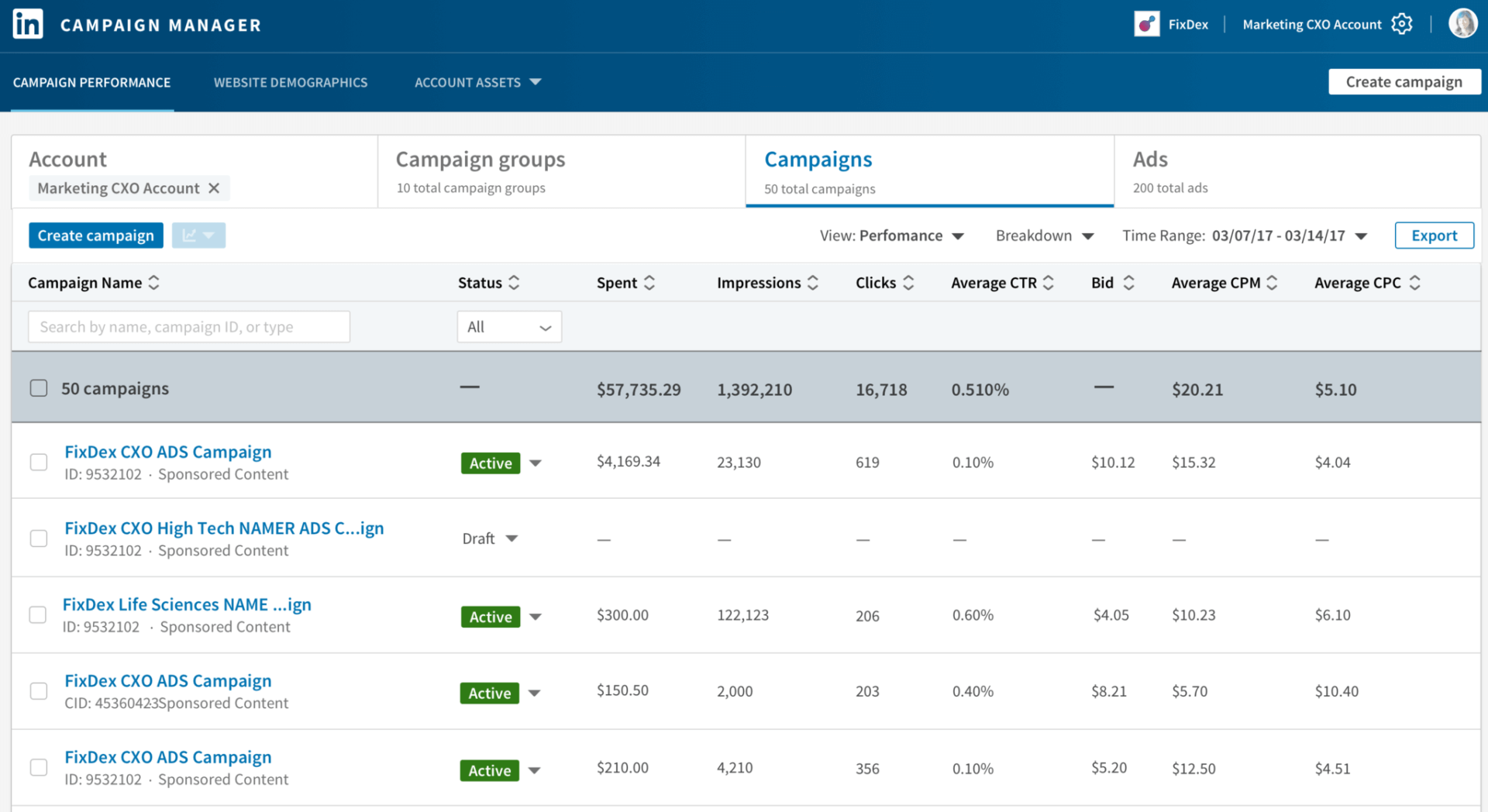
- This report shows metrics like impressions, clicks, and even an “engagement level” for each company that interacted with your campaign. It’s a big step forward, as previously we had no way to see which companies were viewing our ads. Now you can actually get a list of accounts that saw or clicked your ads. That’s great for intent data: it’s telling you which target accounts are paying attention.
- However, there’s a catch: LinkedIn’s native Companies tab lumps everything together at the account level (for the entire ad account). So, if you’re running multiple campaigns or messaging tracks, the native report can’t distinguish what exactly the account engaged with. For example, say you have two different value propositions or products, each with its own LinkedIn ad campaign. If Acme Corp appears in the Companies tab, you know they engaged somehow, but you won’t know which campaign (Feature A or Feature B) caught their attention. Userpilot, for instance, had different intent-based ads as the very foundation of its strategy:
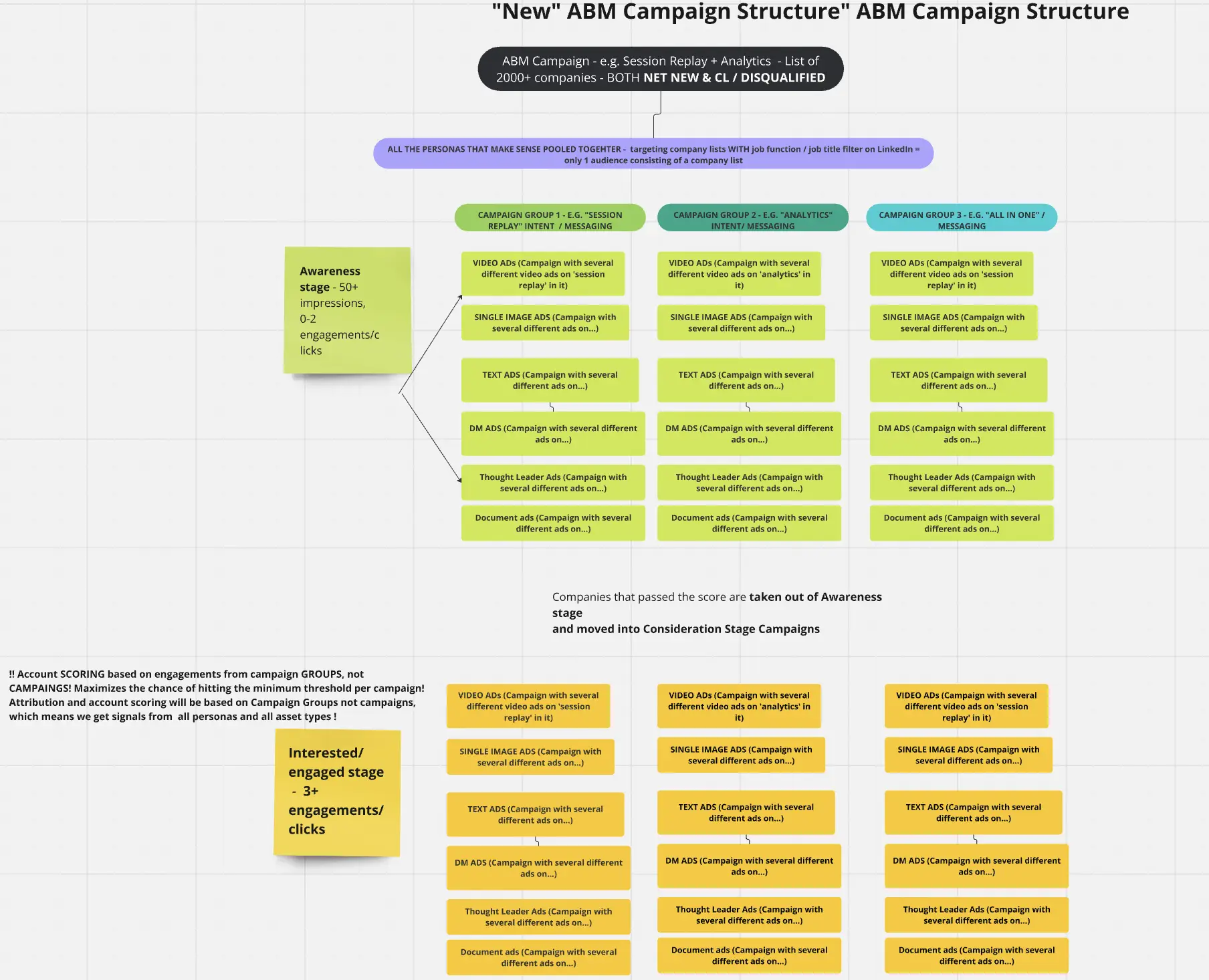 Now, from an intent standpoint, not being able to see company-level engagement at the campaign level is a huge missing detail. I mean, wouldn’t your sales team love to know if Acme is interested in Feature A vs. Feature B to personalise their pitch?
Now, from an intent standpoint, not being able to see company-level engagement at the campaign level is a huge missing detail. I mean, wouldn’t your sales team love to know if Acme is interested in Feature A vs. Feature B to personalise their pitch?- To truly use LinkedIn engagement as an intent signal, you need to break it down by campaign and even by ad creative. In practice, this means using LinkedIn’s reporting at a granular level or pulling data via the API. With the right tooling (ZenABM), you can see something like: Acme Corp – 15 impressions, 2 clicks on Campaign X (focused on use-case A); 7 impressions, 0 clicks on Campaign Y (use-case B).
- LinkedIn ad analytics can also reveal surge behavior. Look for spikes like 0 to 50 impressions in a week or sudden multiple clicks. This often signals a new buying project. Unlike third-party intent data, here, the engagement has been created by your own ads on LinkedIn, so this intent data is first-party data.
LinkedIn Ad Analytics Data Points that Matter Most for Account Scoring
Not all engagement metrics are created equal.
When constructing an account scoring model from LinkedIn analytics, focus on these first:
Impressions
Baseline metric: how many times your ad was shown to the account. High counts mean repeated exposure, not intent. A sudden jump, especially with a frequency cap, can mean more people from that company entered your audience. Include impressions in scoring to credit exposure and capture view-through interest.
Clicks
Clicks show active interest. At the account level, a click means someone took action. Prioritize clicks higher than impressions. Watch CTR, for example, 10 impressions and 3 clicks is unusually high and should boost the score. The Companies tab shows clicks per account, and exported or API data lets you calculate CTR per account.
Engagements (Reactions, Comments, Shares)
These signal public interest. Comments or multiple reactions indicate high engagement, trigger a sales follow-up. Even a Like can be weighted above a click because it shows on-platform content resonance. LinkedIn counts these social actions in engagement metrics, and they are available via API.
Lead Generations (Form Fills)
Lead Gen Form submissions are top-tier signals, equal to or above a demo request. The Companies tab shows lead counts for lead gen campaigns. One form fill from a target account can justify a high score.
Spend or Ads Served
Not a behavior, but high spend on an account signals heavy targeting and reach. If you spent a large amount to reach Acme last quarter, they were costly or saw many ads. Use this as a diagnostic to judge whether engagement justifies continued spend. If impressions are in the model, raw spend is usually unnecessary for scoring.
Shameless plug: All this is available to be tracked in ZenABM (more on this later in the article).
Steps to Design an Account Scoring Model Using LinkedIn Ad Analytics
Here’s a step-by-step approach to creating a scoring model for account engagement using LinkedIn ad data:
Step#1: Define Your Scoring Criteria
Decide which LinkedIn metrics to include. As discussed, impressions and clicks are the primary ones. Let’s say you choose impressions, clicks, and LinkedIn lead fills (if applicable). You might also include an “engagement” count if you want to group likes/comments with clicks, but to keep it simple, let’s focus on impressions and clicks for now.
Step#2: Assign Point Values or Weights
Give each metric a weight that reflects its importance. For example:
- 1 point per impression
- 5 points per click
- 10 points per LinkedIn lead form submitted (if you use Lead Gen Forms)
These numbers can be whatever makes sense for your business – the ratio matters more than the absolute value. The idea here is that clicks are ~5x more indicative of intent than a mere impression, and an actual lead form is even more indicative, hence a higher score. If you also want to factor in reactions or comments, you might slot them in at, say, 7 points each (somewhere between a click and a lead form in intent strength).
Step#3: Incorporate Recency
Build in a time decay.
Accounts that engaged heavily 12 months ago but have gone quiet shouldn’t outrank accounts that started engaging last week.
There are a few ways to do this. One simple method is to have two scores: recent score (e.g. last week’s activity) and all-time score. Or, you could subtract points for periods of inactivity (e.g. minus X points if no clicks in the last 60 days).
Step#4: Set Thresholds for Qualitative Buckets
Decide what score ranges constitute cold, warm, or hot (or whatever labels you use, such as “aware”, “engaged”, “sales-ready”). For example, you might say:
- Score 0 = Not engaged
- 1–10 points = Aware (they’ve seen some ads)
- 11–30 points = Interested (multiple impressions and at least one click)
- 31+ points = Highly Engaged (multiple clicks or form fills, which makes it ready for sales outreach)
These thresholds will vary based on how much engagement you expect. If your campaigns are high-volume, scores will be higher; adjust accordingly. What’s important is that you have a clear line at which an account becomes worthy of sales attention. Maybe that line is “at least 2 different people clicked” or simply “score above 20 points triggers a BDR to follow up.”
Step#5: Test and Tweak
Backtest the model on historical data. Won accounts should score high before conversion; never-engaged accounts should stay low. Use results to tune weights: raise impressions if clicks are rare; raise clicks if impressions are common. Treat v1 as a draft and keep iterating.
Step#6: Document the Formula
Clearly write out how the score is calculated and make sure your team understands it. For example: “Score = (Impressions in last 90 days * 1) + (Clicks in last 90 days * 5) + (LinkedIn leads in last 90 days * 10). After 90 days, engagements are dropped from the score.” This clarity is useful when communicating to sales why an account is scored a certain way. It also helps if you want to implement it in a system (since a developer or admin might need the formula).
How ZenABM Enables Using LinkedIn Ad Analytics for Account Scoring
I’d be remiss not to share how we tackle all of this at ZenABM, since solving these exact challenges is our bread and butter 😉
Direct Integration with LinkedIn Ads
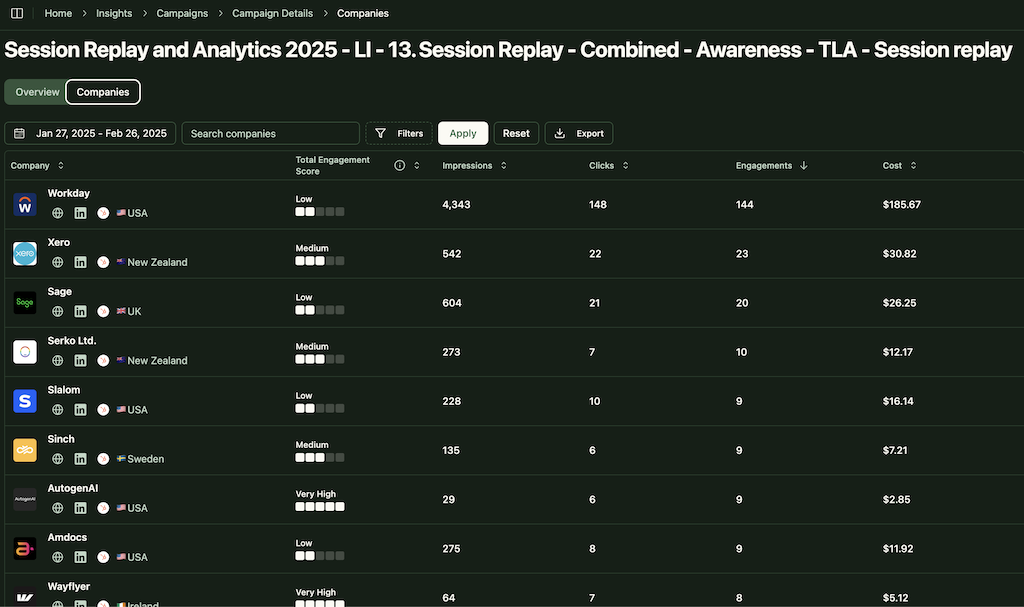
ZenABM connects to the LinkedIn Ads API and pulls in company-level engagement data for each campaign you run. This includes impressions, clicks, and other interactions, broken down by account, for every single LinkedIn campaign and campaign group in your ABM strategy.
The result: you get a detailed view like Company X saw Ad A 5 times and Ad B 3 times, and clicked Ad B once. This is the level of granularity ABM teams need but can’t get from LinkedIn’s native UI.
By having campaign-specific engagement, you immediately know each account’s interests. And because ZenABM uses the official LinkedIn API with first-party data, it’s reliable and compliant (no sketchy scraping or guessing).
Real-Time Engagement Scoring

The platform automatically calculates an Engagement Score for each account based on the LinkedIn data (and you can bring in other channels too).
And the score is available for both ‘recent’ and ‘historic’ activity.
Also, this score updates in real time as new data comes in.
So if Acme Corp suddenly racks up a bunch of ad views and clicks this week, their score will surge accordingly this week, not a month later.
Automatic CRM Sync
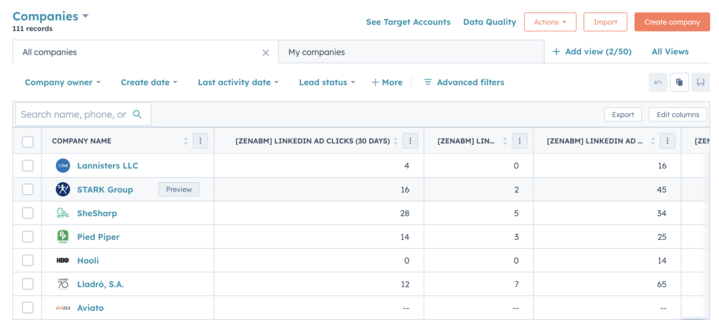
All of the LinkedIn metrics and the resulting scores are pushed to your CRM as company properties automatically, with no code or manual import.
For example, in HubSpot or Salesforce, you’ll have fields like “LI Impressions (Last 30d)”, “LI Clicks (Last 30d)”, and “ZenABM Engagement Score”. This sync is bi-directional and continuous.
What it means for users is that they can use these fields in whatever way they want inside the CRM: reports, list filters, workflow triggers, etc., just like any other property.
Essentially, ZenABM keeps the CRM in the loop with what’s happening on LinkedIn, bridging that gap automatically.
BDR Alerts and Routing

ZenABM doesn’t stop at scoring. It helps you act on the scores. We have built-in automation that will alert your sales team when an account hits a defined score threshold or stage. For instance, you might configure that once an account’s score qualifies it as “Interested” (say 20+ points), ZenABM flags it and can auto-assign that account to a BDR if it’s unowned.
Buyer Intent Tagging
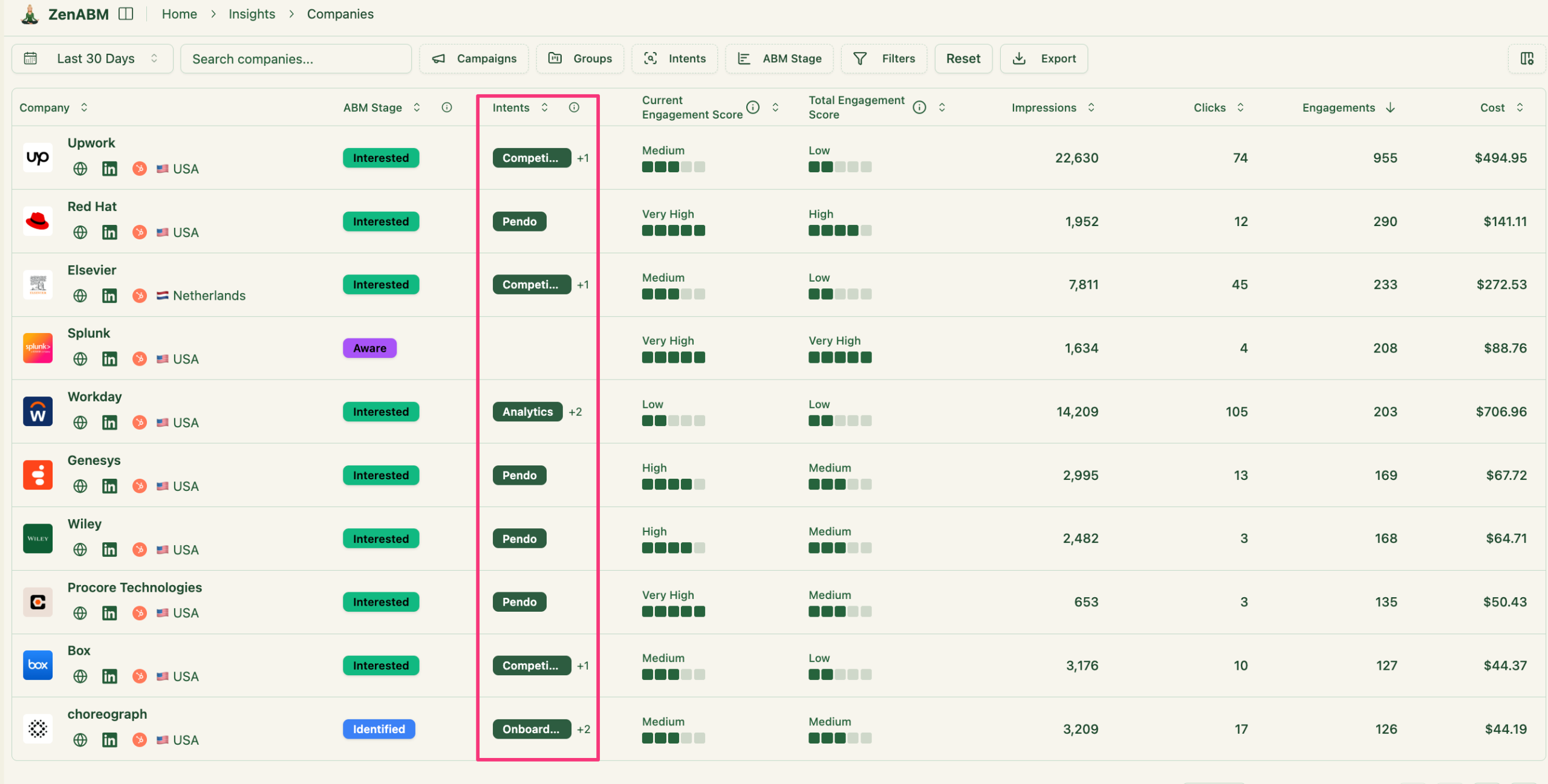
Earlier, I mentioned the importance of knowing what an account is interested in.
ZenABM addresses this by allowing you to tag each LinkedIn campaign or ad group with an intent topic or theme (e.g., product feature, solution area, pain point). The platform then groups engaged accounts by those intent tags. So if Acme engaged with two campaigns tagged “Cloud Security,” ZenABM will cluster Acme under that intent and even sync an “Interest: Cloud Security” flag to your CRM.
For your sales reps, this is a cheat code – they have talking points ready. “Ah, Acme has been engaging with our cloud security content. I’ll make sure to lead with that in my outreach.” This kind of insight is usually hard to get; reps often ask marketing, “What have they been looking at?” and with ZenABM, it’s plainly visible.
ABM Funnel Stage Tracking

ZenABM uses a customizable engagement funnel (Aware, Interested, Considering, Selecting, etc.). It auto-classifies accounts from LinkedIn and CRM signals, advances them as engagement grows, and lets you set thresholds:
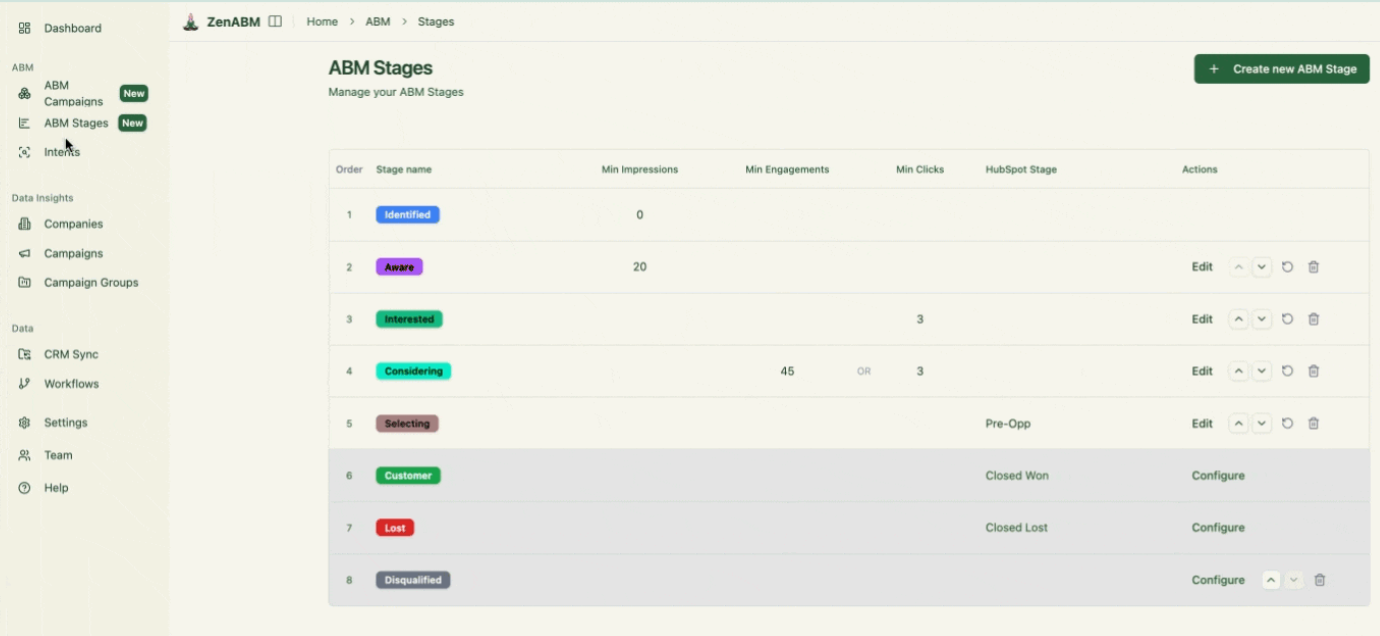
Full-Funnel Revenue Attribution and Reporting Dashboards

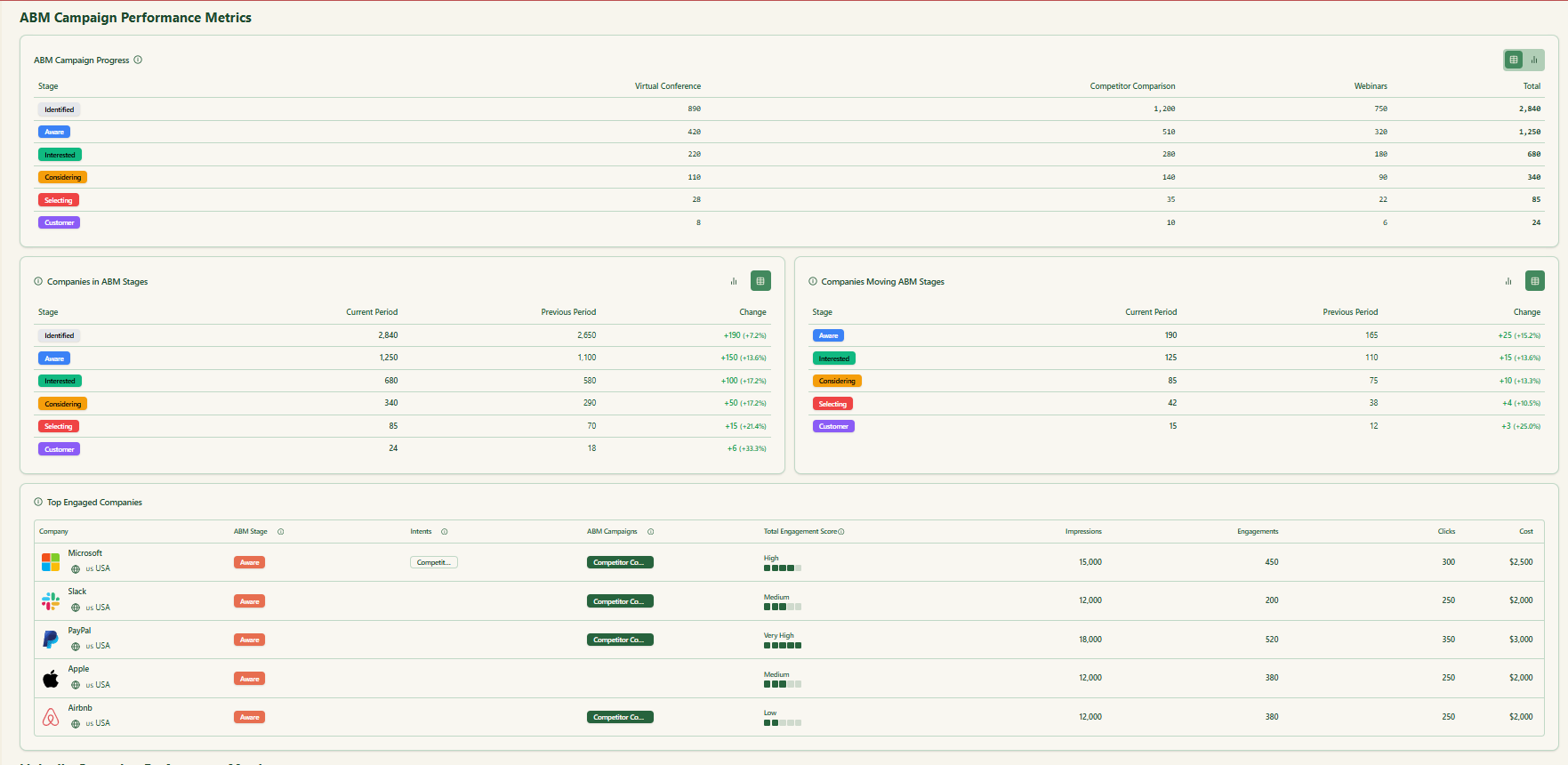

Since ZenABM ties into both LinkedIn and your CRM, it can connect the dots from ad spend all the way to revenue. On the reporting side, it will show you which accounts saw or clicked ads and later became opportunities or closed deals.
It basically performs the attribution analysis that we wish LinkedIn’s native tools did.
For instance, you can get a report like “$500k of pipeline was influenced by Campaign A” or “Campaign Group X sourced 10 opportunities.”
We’ve built dashboards that present metrics like Pipeline per Account, Pipeline per $ Ad Spend, ROAS (Return on Ad Spend), and top engaged accounts by stage.
All of this uses the underlying account-level data from LinkedIn combined with CRM outcomes. The benefit is that you not only score accounts for sales, but you also prove to leadership what your LinkedIn campaigns are doing in concrete terms (influencing pipeline or revenue).
Conclusion: Turn LinkedIn Insights into ABM Action
LinkedIn ad analytics is buyer intel, not just ad math.
In ABM, every impression or click is an account-level signal.
Score it to prioritize who to engage, when, and with what. Lead-level metrics miss this; LinkedIn’s company-level data fixes prioritization.
Close the insight-to-action gap: wire the data, run a scoring model, and auto-alert sales when a target spikes.
Want account scoring using LinkedIn ad analytics out of the box?
Try ZenABM now for free or book a demo to know more!

